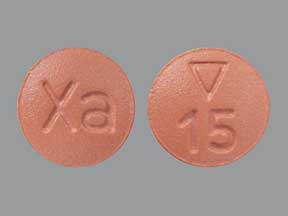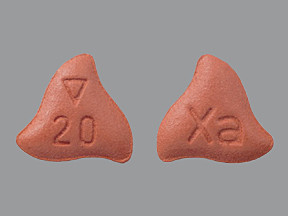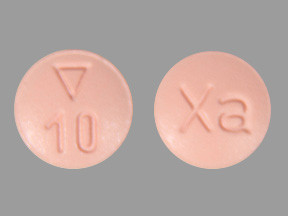RIVAROXABAN - ORAL
PHONETIC PRONUNCIATION: (RIV-a-ROX-a-ban)
COMMON BRAND NAME(S): Xarelto
GENERIC NAME(S): rivaroxaban
Uses
USES: Rivaroxaban is used to prevent blood clots from forming due to a certain irregular heartbeat (atrial fibrillation) or after hip or knee replacement surgery. It is also used to treat blood clots (such as in deep vein thrombosis-DVT or pulmonary embolus-PE) and to prevent the blood clots from forming again. Rivaroxaban is an anticoagulant that works by blocking certain clotting proteins in your blood.
How to use RIVAROXABAN - ORAL
HOW TO USE: Read the Medication Guide provided by your pharmacist before you start taking rivaroxaban and each time you get a refill. If you have any questions, ask your doctor or pharmacist. Take this medication by mouth as directed by your doctor. If you are taking this medication to prevent blood clots after knee or hip replacement surgery, the dose is usually taken once a day. If you are taking this drug to prevent strokes and blood clots that may form due to an irregular heartbeat, the dose is usually taken once a day with the evening meal. If you are taking rivaroxaban to treat blood clots, the dose is usually taken twice a day for the first 3 weeks, and then once a day. To lower the risk of blood clots forming again, this medication is usually taken once a day. Carefully follow your doctor's directions. Do not increase your dose, take it more often, or stop taking it unless you are told to do so by your doctor. The 10 milligrams tablet may be taken with or without food. The 15 milligrams and 20 milligrams tablet should be taken with food. If you have any questions about how to take rivaroxaban, ask your doctor or pharmacist. If you are unable to swallow whole tablets, you may crush the tablet and mix it with applesauce. Eat the entire mixture right away. Do not prepare a supply for future use. If you are giving this medication through a tube into the stomach (nasogastric or gastric tube), ask your health care professional for detailed instructions on how to properly mix and give it. The dosage and length of treatment is based on your medical condition and response to treatment. Use this medication regularly to get the most benefit from it. To help you remember, take it at the same time(s) each day.
Side Effects
Precautions
Interactions
Overdose
Images
Reviews
Faq for RIVAROXABAN - ORAL
Rivaroxaban is an oral anticoagulant medication used to prevent blood clots and reduce the risk of stroke in people with certain medical conditions, such as atrial fibrillation, deep vein thrombosis (DVT), or pulmonary embolism (PE).
Rivaroxaban works by inhibiting the activity of a specific clotting factor called factor Xa, which plays a crucial role in the formation of blood clots. By blocking this factor, rivaroxaban helps prevent the formation of blood clots in the veins and reduces the risk of stroke.
Common side effects of rivaroxaban may include bleeding or bruising more easily, dizziness, headache, nausea, and stomach pain. It is important to notify your healthcare provider if you experience any severe or persistent side effects.
Rivaroxaban should be taken exactly as prescribed by your healthcare provider. It is usually taken once daily with or without food. It is important to follow the instructions on the prescription label and not to adjust the dosage without consulting your healthcare provider.
Yes, rivaroxaban can interact with certain medications and supplements, including other anticoagulants, nonsteroidal anti-inflammatory drugs (NSAIDs), and some herbal or dietary supplements. It is important to inform your healthcare provider about all medications or supplements you are taking to avoid potential interactions.
If you miss a dose of rivaroxaban, take it as soon as you remember on the same day. If you do not remember until the next day, skip the missed dose and continue with your regular dosing schedule. Do not take a double dose to make up for a missed dose.
Moderate alcohol consumption is generally considered safe while taking rivaroxaban. However, excessive alcohol intake can increase the risk of bleeding. It is best to consult your healthcare provider for personalized advice on alcohol consumption.
Unlike some other anticoagulants, rivaroxaban does not usually require regular blood tests to monitor its effect on blood clotting. However, your healthcare provider may order occasional blood tests if necessary.
Your healthcare provider should be informed about any upcoming dental procedures or surgeries if you are taking rivaroxaban. They will determine if any adjustments to your medication or additional precautions are necessary to minimize the risk of excessive bleeding.
Warning
WARNING: Do not stop taking rivaroxaban unless directed by your doctor. If you stop taking this medication early, you have a higher risk of forming a serious blood clot (such as a stroke, blood clot in the legs/lungs). Your doctor may direct you to take a different "blood thinning" or antiplatelet medication to reduce your risk. Get medical help right away if you have weakness on one side of the body, trouble speaking, sudden vision changes, confusion, chest pain, trouble breathing, pain/warmth/swelling in the legs. People taking this medication may bleed near the spinal cord after certain spinal procedures. Bleeding in this area can cause paralysis that lasts a long time or could become permanent. Ask your doctor about the benefits and risks before any spinal procedure. The risk of bleeding may be higher if you have a deformed spine, or have had spinal procedures/surgery before (such as epidural catheter placement, difficult epidural/spinal puncture), or are taking other drugs that can cause bleeding/bruising (including antiplatelet drugs such as clopidogrel, "blood thinners" such as warfarin/enoxaparin, nonsteroidal anti-inflammatory drugs-NSAIDs such as ibuprofen). See also Drug Interactions section. Tell your doctor right away if you notice symptoms such as back pain, leg numbness/tingling/weakness, loss of control of the bowels or bladder (incontinence).
Disclaimer
IMPORTANT: HOW TO USE THIS INFORMATION: This is a summary and does NOT have all possible information about this product. This information does not assure that this product is safe, effective, or appropriate for you. This information is not individual medical advice and does not substitute for the advice of your health care professional. Always ask your health care professional for complete information about this product and your specific health needs.



No Reviews Yet